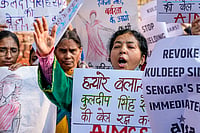Starring: Survinder Vicky, Kanwaljit Singh, Harnek Aulakh and others.
Dir by Guvinder Singh.
Rating: ***

The issue of militancy in Punjab has almost been forgotten, but the violence and trauma the state went through has not been adequately captured in cinema—the only films that comes to mind are Gulzar’s Maachis and Govind Nihalani’s Drohkaal. In fact, almost all films based in Punjab are about happy, singing and dancing folks—an image shattered by the recent Udta Punjab. Gurvinder Singh’s National award-winning Chauthi Koot (Fourth Direction) comes as a reminder of that tumultuous period that had long-term ramifications out of the state, like Operation Bluestar, the assassination of Indira Gandhi and the Sikh pogrom.
Chauthi Koot is set in the ’80s, with Punjab in the throes of the Khalistani separatist movement, and burning in the crossfire between Khalistani militants and security forces. The people are in the grip of fear and uncertainty—and the director has returned to that dark period with poignancy and an evocative use of silence to heighten the tension—when a distant bullet fired, the bark of a dog or squawk of a chicken signals menace.
Based on two short stories by Waryam Singh Sandhu, the film is about the suffering of ordinary people, not the grandstanding of militants or the pornography of violence that many directors resort to, because reality would be too difficult for an audience to bear—the men killed in police encounters; innocents pulled out of buses and shot.
The first story is about an order issued by militants that forbade pet dogs from barking and the other is about two Hindu friends, Jugal (Kanwaljit Singh) and Raj (Harnek Aulakh), travelling to Amritsar in a freight train, with a few other men. Jugal narrates the story about himself, his wife and daughter, of the time when they asked for directions at the isolated house of Joginder (Survinder Vicky). He is the farmer asked by terrorists to kill his barking dog, so that the army does not find their hiding place in the fields. The next day, the armed forces arrive, looking for the militants and ransack the house.
Singh’s style is minimalistic, the tragedy of those times is written on the desolate faces of the characters—most of them amateurs. Satya Paul’s camera captures the beauty of rural Punjab, which seems to yearn for peace and normalcy. Everything from the cinematography to the sound design and acting is realistic and low-key, which is the strength of Chauthi Koot, but a weakness too, because the lay audience—as opposed to festival film buffs—expects some drama.


























